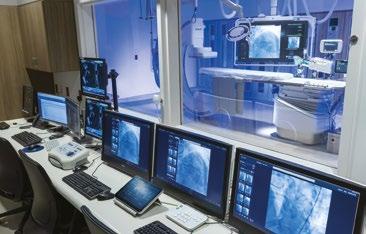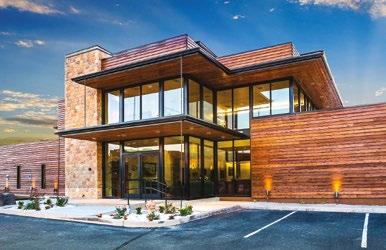
9 minute read
Technology and Healthcare in Central Arizona
By Kristina Abbey
Improving Quality of Life Through Medical Innovation.
A trip to the doctor’s office has changed quite a bit in the past several years. You are more likely to see your doctor use a laptop or iPAD to type medical notes directly into your digital file than handwrite notes for paper records. The paper prescription pad has become virtually obsolete as prescriptions are instead transmitted wirelessly to the office printer or sent directly to the pharmacy of your choice.
One of the biggest changes to a doctor’s visit is the growing use of telemedicine. Telemedicine has become a much more common and has steadily grown as a preferred way for patients to consult their physicians. According to the CDC, “during the first quarter of 2020, the number of telehealth visits increased by 50%, compared with the same period in 2019, with a 154% increase in visits noted in surveillance week 13 in 2020, compared with the same period in 2019.” While the pandemic clearly impacted those numbers, telemedicine was already well on its way to becoming part of standard medical care.

Using a variety of digital communication technologies, patients can consult their physicians without an office visit. Instead, they can talk to their doctors via video chat, email, online portals or phone from the comfort of their own homes.
While it won’t likely replace in-person visits entirely, telemedicine can save time and travel for many non-emergency medical appointments.
The technology behind telemedicine is fairly simple. A stable high speed internet connection is needed for the best video and audio quality. Telemedicine also relies on a stable video platform, which usually means using a secure and encrypted computer application. These video platform apps must also be in compliance with the Health Insurance Portability and Accountability Act of 1996 (HIPAA). The other key component is information technology (IT) support. Other than broadband internet, a secure video platform and reliable IT support, many physicians also use peripheral technology for recording and securely storing the video and audio recorded during the appointmet for their patient’s records.
Beyond telemedicine, innovations in medical technology have impacted the healthcare field overall. Everything from a routine office visit to medical imaging, patient care, diagnostics and prevention have been improved by advancements in tech. Many of these new technologies are currently in use right here in Yavapai County at medical facilities like Thumb Medical Center, Yavapai Regional Medical Center and the Northern Arizona VA Healthcare system.

Photo courtesy of Thumb Butte Medical Center
Thumb Butte Medical Center
Thumb Butte Medical Center has integrated an array of medical technology into all three of their locations. Medical Director Dr. Hojat Askari, M.D., is committed to ensuring that all locations offer the latest advancements for their patients. “Our mission is to provide excellent and accessible medical care. We treat our patients with the utmost respect, dignity, and honesty in a healing environment,” he said.
With 30,000 square feet, the Prescott location is a state-of-the-art multi-specialty medical clinic. The goal is to provide services to area residents capable of treating everything from internal medicine, cardiology, allergy treatment, foot and ankle surgery, and dermatology.
The Orthopedic Specialists at Thumb Butte Medical Center use Platelet Rich Plasma (PRP) treatments for joint pain and injuries. This treatment involves using stem cells to harness the healing power of the patient’s own body. The typically in-office PRP treatment involves injections into the injured area to decrease inflammation and pain, stimulate healing, and speed repair for bone, muscle, joint, ligament, and soft tissue injuries as a way to decrease the need for surgery.
Thumb Butte Medical Center also has plans to open a new Radiology Center soon, and will have two types of magnetic resonance imaging (MRI) scanners. MRI machines create detailed images of internal organs and tissues within the human body. Basically, this is achieved by using magnetic fields and radio waves to measure the amount of water in different body tissues. The picture is based on how hydrogen protons behave within the magnetic field, or BO field, when hit with a pulse of radio frequency (RF). MRI machines generate detailed images based on the information from this process.
The Radiology Center will have two types of MRI machines for their patients, the 3T MRI scanner and an Open MRI machine. The s3T MRI scanners work by generating a very strong magnetic field, typically twice as strong as a traditional MRI machine. These 3T MRI scanners have several advantages. They are much faster, produce more detailed images and can correct for slight movement from the patient, like breathing. While there are a lot of benefits, the 3T MRI is a closed scanner that is not ideal for people with anxiety. In that case, the better option might be an open MRI. While open MRI machines work on the same principles as the 3T ones, they are slower and the images less detailed.
Dr. Askari and his team at Thumb Butte Medical Center are continuously integrating new technology to provide the best medical care possible. “We have over 20,000 patients, plus we’re seeing about 30-40 brand new patients every day,” said Dr. Askari. “We take care of people who have no insurance, we welcome everybody, and we never say no to people when they need help.”

Photo courtesy of Yavapai Regional Medical Center
Yavapai Regional Medical Center
Yavapai Regional Medical Center (YRMC) has a national reputation for being a leader in technological and digital solutions for patient care. Among other distinctions, the American Hospital Association’s Health Forum has recognized YRMC as a Most Wired Hospital on multiple occasions.
YRMC has introduced a new Cardiac Catheterization Laboratory at the James Family Heart Center at YRMC West in Prescott.
The new Cardiac Cath Lab incorporates technology so advanced that it is the first of its kind in the western United States. “The innovative technology and clinical expertise allow us to deliver highly advanced structural, coronary, peripheral, and electrophysiological procedures to our community,” said Soundos Moulla, MD, FACC, FSCAI, Medical Director, Structural Heart Program, James Family Heart Center at YRMC.
In the new Cardiac Cath Lab, there are two pieces of innovative diagnostic imaging equipment, the Azurion Angiography Operating System, and the EchoNavigator. The Azurion Angiography Operating System gathers a combination of x-ray and ultrasound images that are combined into a single, three-dimensional view of a patient’s heart. The EchoNavigator technology introduces “road mapping” which combines the Azurion’s three-dimensional images into a clear and detailed “map” of a patient’s heart. These images allow physicians to see the vessels, valves, leaflets, and more in real-time. This tech gives interventional cardiologists a clear view of the catheter or heart implant they are guiding during an angiography procedure.
In addition to the new Cath Lab, YRMC uses cutting edge medical technology in other areas of care.
YRMC uses Prostate Magnetic Resonance Imaging (MRI) to diagnose conditions of the prostate - the walnut-sized gland below the bladder in men. “Prostate MRI can prevent some biopsies and give urologists the information they need to perform targeted biopsies,” said Deven Cox, DO. Cox is a YRMC Diagnostic Radiologist who is fellowship trained in Body Imaging. The Prostate MRI allows diagnostic radiologists to answer three essential questions about prostate cancer: Where is the tumor located in the prostate gland? How aggressive is the tumor? Has the cancer spread outside of the prostate gland?
There have also been tech developments used to diagnose and track neuroendocrine tumors. Recently introduced to YRMC East in Prescott Valley, Gallium-68 DOTATATE Positron Emission Tomography (PET) is helping radiologist locate these hard-to-find tumors which can be found in the pancreas, stomach, intestines, a gland in the abdomen, or the lungs.
“For people who suffer from neuroendocrine tumors, the availability of this imaging study in Prescott Valley is very good news,” said Shaun Walton, CNMT, Supervisor, Nuclear Medicine, and PET/CT at YRMC. “This study is faster and offers more specificity than other neuroendocrine tumor studies.”

Photo courtesy of Northern Arizona VA Healthcare
Northern Arizona VA Healthcare System
The Northern Arizona VA Healthcare System (NAVAHS) works tirelessly to ensure patient care is efficient. Part of that achieving that goal is met by bringing technology into the systems, treatment and diagnostic services.
Technology can often go beyond machinery and equipment in the office or exam room. Some of the most important tech advancements have been in how appointments are booked and communication with patients. One method that NAVAHS uses is the VA Telemedicine service.
While VA Telemedicine is not new, the system saw a massive increase in patient use in 2020. In Fiscal Year (FY) 2019, there were a total of 5,439 telemedicine appointments, but in FY2020 the reported number increased to 7,081 appointments with 30 days remaining in the fourth quarter of FY2020.
My Healthy Vet, another patient service, is a secure online patient portal that allows individuals to check medication status, order refills, and check appointments. Patients can also communicate with both their healthcare providers and their pharmacy using the My Healthy Vet service. Offered by both secure web portal and secure cell phone app, patients have efficient means of using tech to stay current on their healthcare needs. In 2020, NAVAHS reported that 44% of their patients are using My Healthy Vet.
NAVAHS is also currently working to expand their radiology clinic by 8,000 square feet. The additional space will allow NAVAHS to increase the number of Veterans who can receive care. The expanded radiology clinic will also introduce a variety of state-of-the-art imaging equipment. Equipment in the radiology clinic will include Dual-energy computed tomography (CT), Wide Bore MRI System, Dual Energy X-Ray Absorption Imaging.
Dual-energy CT allows for hi-definition, image clarity, and the addition of metal artifact reduction/removing software through a variety of x-ray imaging techniques. This goes beyond anatomical analysis and allows for quantitative tissue characterization and advanced functional imaging. The Dual-energy CT has features like advanced imaging, 3D and 4D software, and uninterrupted power system (UPS) which allow for 30 minutes of continued screening during a power outage or surge. The Wide Bore MRI System allows for patient comfort offering quiet, quick scanning capabilities and also adjusts for patient motion like breathing, detecting and correcting as needed.
In the past, Dual-energy X-Ray Absorption Imaging has been specific to bone mineral density. Going forward and partnering with clinical dietician/nutritional services NAVAHS will be able to perform body composition analysis which will help improve clinical-nutritional care to meet target body weight as well as give precise, accurate measurement on each individual patient.
Thumb Butte Medical Center, Yavapai Regional Medical Center, and the Northern Arizona VA Healthcare System are just three examples of how tech is being incorporated into healthcare.
With the introduction of new technology in the various healthcare services and treatments in the Quad Cities, patient care continues to improve and become more effective.
As the Northern Arizona region grows, medical facilities are likewise incorporating and constantly updating their technology to provide the best possible care for their patients.










